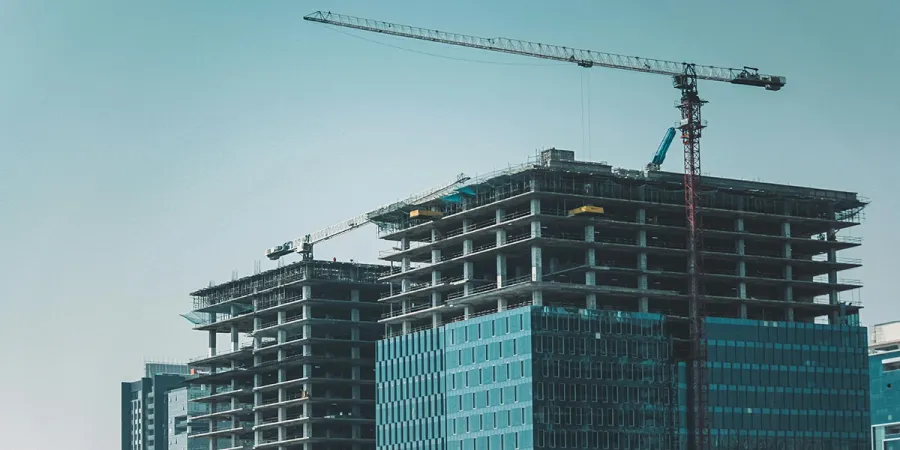A comfortable house with a terrace and lawn, a barbecue, and a playground, and the opportunity to spend more time outdoors rather than in a stuffy apartment with annoying neighbors are just some advantages of living in a private house. That’s why today, more and more people are choosing to build their own homes.
Would you like to build your own home but don’t know where to start? We’ll tell you about the main steps to building a house.

How to Build a Private House
Building a home is one of the most important and rewarding projects in anyone’s life. However, it’s important to understand that the process of building a house is quite complex, requiring a significant amount of time, specialized knowledge, and careful budget planning. We’ll tell you about the main stages of building a private house.
Choosing a Plot
When searching for land to build a residential home, it’s important to consider several factors:
- Road infrastructure: Check the availability and proximity of public transportation stops. The presence of access roads and the quality of road surfaces are also important.
- Size: The plot should correspond to the area and design of the future housing project.
- Terrain: If the plot is sloped, preparing for construction will require additional costs for earthworks, planning, and drainage.
- Social infrastructure: It’s worth finding out how close to your future home there will be a daycare center, school, shop, and clinic.
- Availability of engineering communications: It’s necessary to find out how close engineering networks are to the plot. This will directly affect the cost and timing of connections.
Preparing the Project
You can create a project yourself or order it from an architectural company. In the latter case, you will be provided with a detailed sketch showing the building layout and all information about the object (dimensions of details, quantity of materials, sizes of openings and wall widths between them, plan of placement of engineering networks).

Determine important parameters when choosing a project:
- Layout
- Area and number of rooms
- Number of bathrooms
- Configuration of additional rooms (walk-in closet, boiler room, pantry)
- Roof shape
- Window shape
At this stage, the site for house construction is prepared. For this, you will need to:
- Ensure access to the site.
- Plan the location of the house, auxiliary buildings, garden, and other areas, and choose a location for laying engineering communications.
- Get rid of unnecessary vegetation on the site.
- Carry out earthworks and planning work to level the site.
- Conduct engineering-geological surveys—this will determine the soil composition, soil density, and depth of groundwater occurrence.
- Install communications.
Choosing Construction Technology
What to build your own house with is a personal choice. There are many construction options, each with its own advantages and disadvantages. When choosing materials, it is important to consider several factors simultaneously—the terrain of the site, soil composition, budget, and desired construction timelines.
There are two main technologies:
- Houses made of brick, stone, cellular concrete, or blocks. Compared to other materials, this option ranks first in terms of durability and reliability. Stone houses are strong and resistant to any weather conditions. The downsides include high cost, long construction period and settlement (1 to 2 years), and high heating costs.
- Frame houses. A more modern technology (also called Finnish or Canadian) involves the use of SIP panels. These are ready-made blocks in which the cladding is bonded to the insulation. The advantages of this technology are fast construction (1 month), low cost, absence of settlement, and good insulation. The main disadvantage is the need for expensive ventilation systems.

Choosing a Contractor
You can choose a single construction company that will build the entire house or use the services of different companies for each type of work. Since each contractor has their own vision and standards of work, it’s better to choose the first option; “foreign” teams may not agree with other decisions.
When choosing a construction company, check their qualifications, look at a portfolio with already completed houses, and even better—come and see with your own eyes the object your contractor is currently building.
Draw up a contract with the organization, clearly indicating the scope of work and the deadlines for their completion. Establish a payment schedule—payment is made in stages after acceptance of each individual type of work. Along with the contract, create a detailed construction estimate indicating the cost of each stage. Establish a procedure for action in case one of the parties fails to fulfill their obligations.
The contract specifies who is responsible for purchasing building materials. This can be either the contractor or the client themselves. However, it is more advisable to entrust the purchase of materials to the contractor, as construction companies can purchase building materials at a large discount. If in doubt, you can check the price yourself and compare it with the price offered by the construction company.
Building the House
Building steps:
- Foundation pouring.
- Wall construction.
- Roof installation.
- Installation of windows and exterior doors.
- Facade finishing.
The duration of each stage will depend on the chosen construction technology. Then, you can proceed to the interior works—laying pipes, wiring, and internal finishing.
Stages and Order of Interior Finishing Works
- Enclosing the perimeter. Involves the installation of all door units and window structures in accordance with the project documents.
- Electrical wiring installation.
- Plastering works.
- Heating system connection.
- Final screed for leveling.
- Flooring installation.
- Wall finishing (wallpapering, painting), installation of decorative tiles.
After fulfilling the contract conditions, the owner and the contractor sign an acceptance certificate.
Registration of Property Rights to the House
After completing the construction, it is necessary to contact a cadastral engineer who will take measurements and prepare a technical plan of the house. The finished plan, along with the documents for the plot and notification of compliance with construction parameters, must be submitted to the local administration.
To build a home of your dreams is a wonderful idea. However, before starting construction, it is important to soberly assess your strengths and capabilities, both physical and financial. Thorough planning of each stage of construction is the key to future success.






